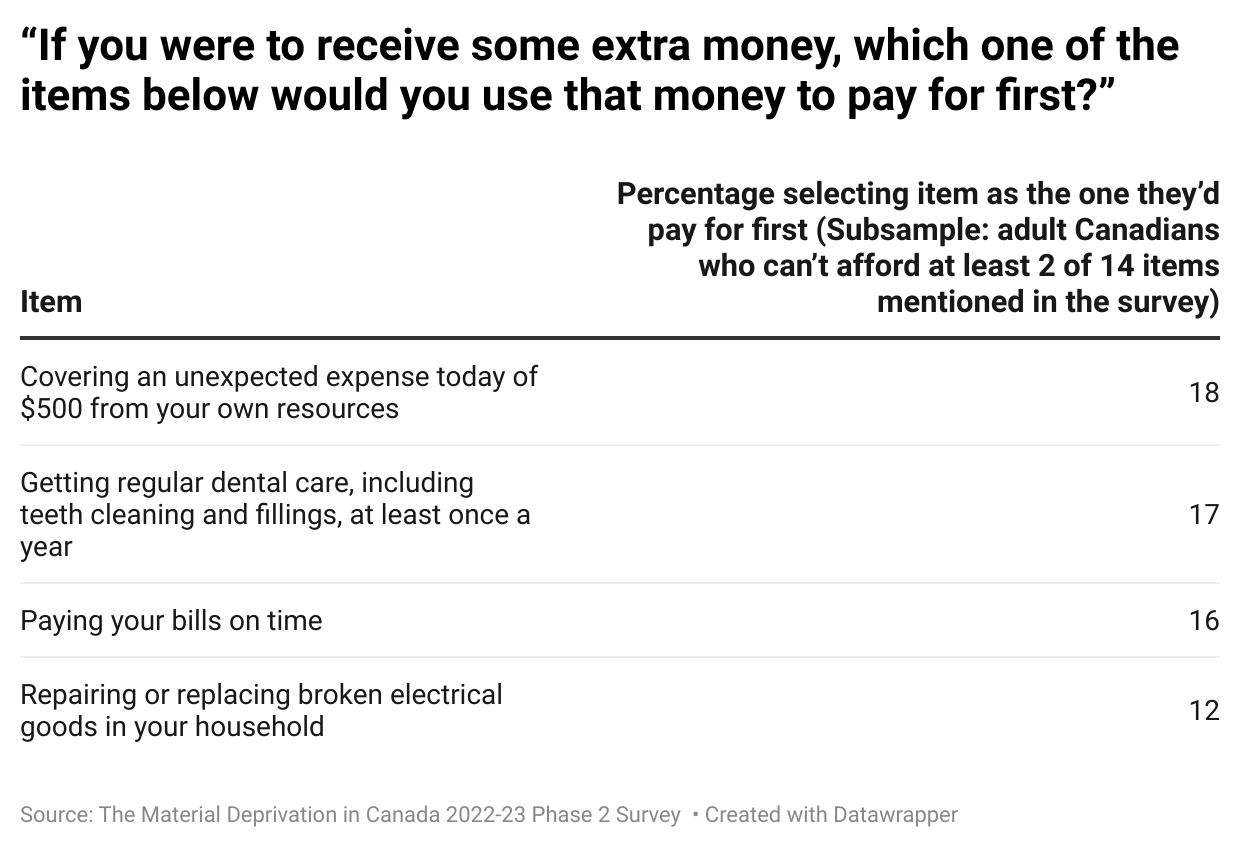How big an issue is affordable dental care?
What we can learn from the recent study of material deprivation in Canada
Have you heard of the “material deprivation index” (MDI)?
It’s a different measure of poverty that goes beyond the traditional income-based thresholds to look at what households can afford to buy or to do with the income they have. Among other things, it helps to explain the discrepancy between the official poverty rate, which has been falling, and the growing number of Canadians who are having difficulties making ends meet.
A team of researchers1 led by Food Banks Canada recently piloted the index; the extensive research report, and a more succinct summary of their findings, are available here. Another explainer was recently published in Policy Options. In short, the study found that “25 per cent of Canadians likely have a poverty-level standard of living according to a material deprivation threshold.”
The Environics Institute supported this project by managing the two surveys the researchers relied on. In developing the second survey, we decided to add an extra question that wasn’t part of the MDI itself, but which produced results worth sharing (and that’s what this Substack is for!).
The MDI is based on questions asking Canadians whether they have access to 14 specific items, and, if not, whether it’s because they can’t afford them. The additional question was asked to anyone who said they couldn’t afford at least two of the 14 items.2 These people were presented with the list of items they said they couldn’t afford, and asked:
“If you were to receive some extra money, which one of the items below would you use that money to pay for first?”
Here’s the list of the most common items mentioned:
Not surprisingly, the most commonly mentioned item relates to having a minimal buffer in your budget. The third and fourth items in the list are similar – they are more or less about being able to pay for things as they arise, be they the electricity bill or the need to keep your computer working.
But the second item caught my eye: having enough money to pay for a visit to the dentist.
Photo credit: Tima Miroshnichenko
What this means is that, among Canadians who meet the material deprivation threshold (they can’t afford 2 items or more from a list of 14), one of their top priorities is having enough money to pay for dental care.
By extension, we can conclude that basic dental care – along with keeping some money around for unexpected expenses, paying your bills on time and paying for household repairs – is what many Canadians choose to cut back on first when money gets tight.
This group of respondents includes those who say they can’t afford any two of the items on the list – so not all of them said they were lacking access to dental care specifically. But, in practice, lack of access to dental care is one of the most commonly mentioned items in the survey. Overall, 18 percent of adult Canadians report that they (or members of their household) can’t afford to get regular dental care, including teeth cleaning and fillings, at least once a year. Of this group, 35 percent would choose to pay for dental care first, before any of the other items, if they were to receive some extra money. This is more than twice as many as the next more commonly selected priority for this group, namely paying their bills on time (16%).
In practice, lack of access to dental care is one of the most commonly mentioned items in the material deprivation survey. Overall, 18 percent of adult Canadians report that they (or members of their household) can’t afford to get regular dental care, including teeth cleaning and fillings, at least once a year.
I’ll leave it to the policy pundits to discuss whether the new federal dental care program is the right priority for government, or has been designed and implemented in the right way. I am here neither to applaud nor criticize government initiatives.
But the recent study of material deprivation in Canada finds that an important number of Canadians cannot afford to pay for basic dental care – and, among those in this situation, many would use any additional money they might receive to cover that expense before anything else. It’s worth noting.
It also highlights one of the advantages of the material deprivation study — namely, it’s ability to pick up quickly on changing conditions. If Statistics Canada, for instance, integrates the questions into one of their income studies in the near future, we could see whether – and to what extent – the new federal program affects both the proportion of Canadians who say they can’t afford basic dental care, and the overall deprivation rate in the country.
The Material Deprivation in Canada 2022-23 Phase 2 Survey was conducted from April 18 to May 17, 2023 with a sample of 4,624 adult Canadians. It was conducted by the Environics Institute for Food Banks Canada/Banques ailimentaires Canada. The author is solely responsible for any errors of presentation or interpretation.
What is the Environics Institute for Survey Research? Find out by clicking here.
Follow us on other platforms:
· Twitter: @Environics_Inst or @parkinac
· Instagram and Threads: environics.institute
The team consisted of: Geranda Notten, Graduate School of Public and International Affairs, University of Ottawa; Sofia Seer, Food Banks Canada; Michael Mendelson, Maytree Fellow; and Richard Matern, Food Banks Canada.
The unweighted sample size for this group is 1,412.







Interesting. Wouldn't have thought so high up on the list.